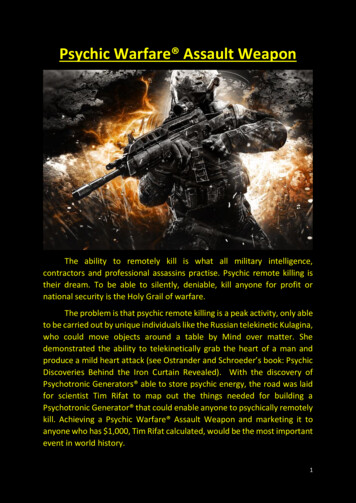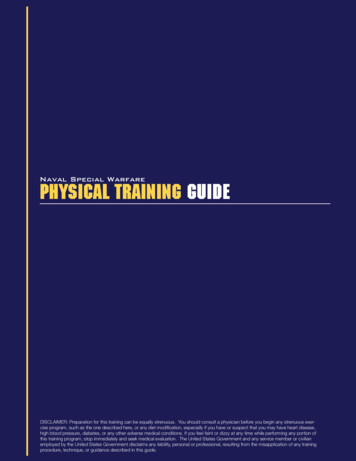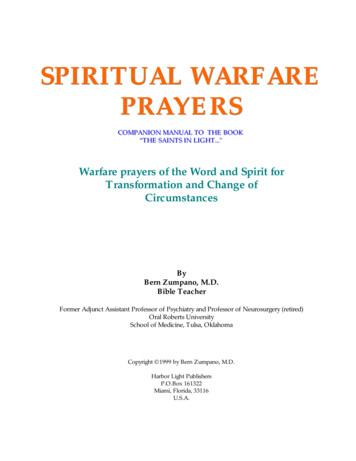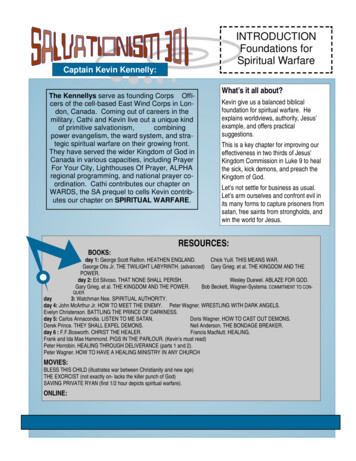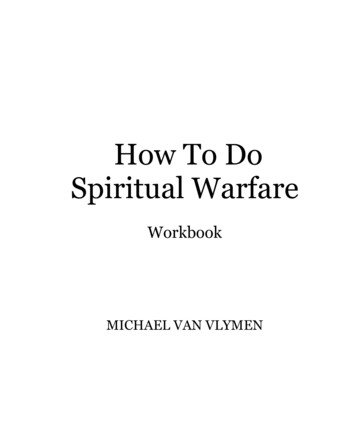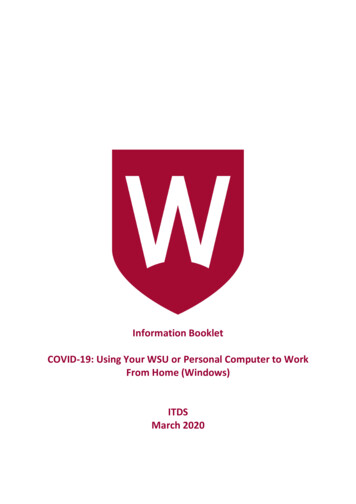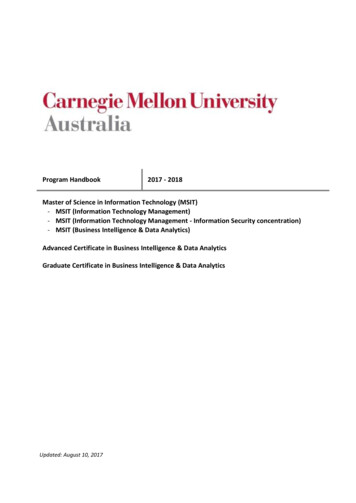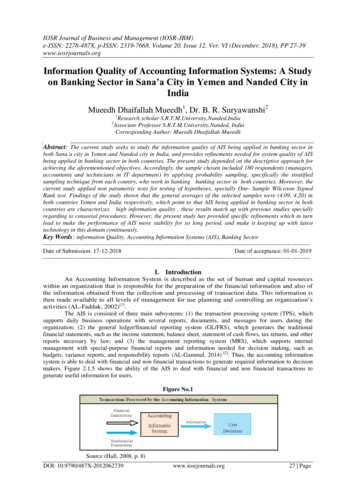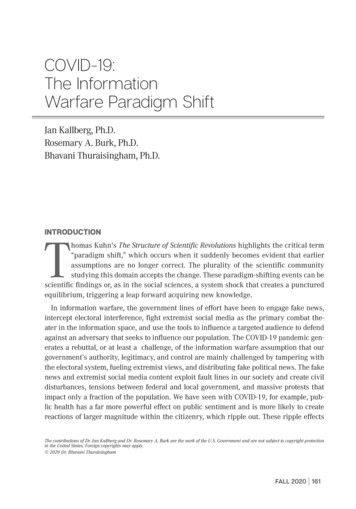
Transcription
JAN KALLBERG : ROSEMARY A. BURK : BHAVANI THURAISINGHAMCOVID-19:The InformationWarfare Paradigm ShiftJan Kallberg, Ph.D.Rosemary A. Burk, Ph.D.Bhavani Thuraisingham, Ph.D.TINTRODUCTIONhomas Kuhn's The Structure of Scientific Revolutions highlights the critical term“paradigm shift,” which occurs when it suddenly becomes evident that earlierassumptions are no longer correct. The plurality of the scientific communitystudying this domain accepts the change. These paradigm-shifting events can bescientific findings or, as in the social sciences, a system shock that creates a puncturedequilibrium, triggering a leap forward acquiring new knowledge.In information warfare, the government lines of effort have been to engage fake news,intercept electoral interference, fight extremist social media as the primary combat theater in the information space, and use the tools to influence a targeted audience to defendagainst an adversary that seeks to influence our population. The COVID-19 pandemic generates a rebuttal, or at least a challenge, of the information warfare assumption that ourgovernment’s authority, legitimacy, and control are mainly challenged by tampering withthe electoral system, fueling extremist views, and distributing fake political news. The fakenews and extremist social media content exploit fault lines in our society and create civildisturbances, tensions between federal and local government, and massive protests thatimpact only a fraction of the population. We have seen with COVID-19, for example, public health has a far more powerful effect on public sentiment and is more likely to createreactions of larger magnitude within the citizenry, which ripple out. These ripple effectsThe contributions of Dr. Jan Kallberg and Dr. Rosemary A. Burk are the work of the U.S. Government and are not subject to copyright protectionin the United States. Foreign copyrights may apply. 2020 Dr. Bhavani Thuraisingham FALL 2020 161
COVID-19: THE INFORMATION WARFARE PARADIGM SHIFThave been hard to predict. The long-term psychological,societal, and health impacts of COVID-19 events havestill not yet unfolded. As an example, according to theNational Bureau of Economic Research, no other historic pandemic event has affected the stock market as profoundly as COVID-19.[1]SOCIETAL PRIORITIESDr. Jan Kallberg is Assistant Professor ofAmerican Politics in the Department of SocialSciences and Cyber Policy Fellow at the ArmyCyber Institute at West Point. He holds a Ph.D.in Public Affairs and a Master’s Degree inPolitical Science from the University of Texasat Dallas, and a J.D./LL.M. from StockholmUniversity. Prior to joining the West Pointfaculty, Jan was a researcher and Post-Doc atthe Cyber Security Research and EducationInstitute, Erik Jonsson School of Engineeringand Computer Science, at the Universityof Texas at Dallas under Dr. BhavaniThuraisingham. Dr. Kallberg’s research interestis the intersection between public leadershipand cyber capabilities, especially offensivecyber operations as an alternative policyoption. His personal website iswww.cyberdefense.com. 162 THE CYBER DEFENSE REVIEWCOVID-19 has provided an essential data set for understanding what matters to the population. The environmental aspect of cyber defense, linked to publichealth, has not drawn attention as a national securitymatter. As living beings, we react to threats to our living space and the immediate environment. Jeopardizing the environment, intentionally or unintentionally,has historically led to the direct injection of fear andstrong reactions in the population. Even unexpectedaccidents with environmental impact have triggeredstrong moves in public sentiment towards fear, panic,anger against the government, and challenges to publicauthority. One example is Chernobyl, which accordingto former Soviet leader Gorbachev was accredited as thereason for the Soviet collapse five years later as the popular lost faith in their government and their ability toprotect their citizens.[2]An adversary seeks effects that support its agenda and strategy. If an adversary engages in information operations, there is a goal and endgame that itis trying to achieve. From the adversary’s perspective, what impact can it have on a US Presidentialelection, and does it matter whether a Democraticor Republican President is elected? What is the upside? The inference is concerning, and adequateresources are dedicated to addressing the problem.[3] However, if we look at the actual changesto policy outcome, the interference will likely notmeet the intended goals of swaying the elections.
JAN KALLBERG : ROSEMARY A. BURK : BHAVANI THURAISINGHAMDr. Rosemary Burk is a Senior Biologist withthe Department of the Interior, U.S. Fish andWildlife Service, Head Quarters, Falls Church,Virginia. She earned a Ph.D. in Biology from theUniversity of North Texas with a specializationin aquatic ecology and environmental science.She has co-authored several articles that havelinked failed cyber defense and environmentalconsequences including "Failed Cyberdefense:The Environmental Consequences of HostileActs," which was published by the U.S. Army’sMilitary Review in 2014.US defense spending and its grand impact on theworld order have been nearly consistent over the decades. Even when presidents and political leaders havemade drastic policy decisions, the actual change in thegeopolitical landscape has been marginal. As a recentexample, President Trump’s movement of troops fromGermany to Poland, Belgium, and Italy is simply a rearrangement and a new geopolitical position. From aRussian perspective, with an increasingly more military-able Poland and increasing commitment fromseveral NATO countries, the US movement of troopsout of Germany does not change the current situation.Until COVID-19, the return on the Russian informationwarfare investment was not present if the intendedgoal were to directly impact US policy and general sentiment. Groups and fragments of the population havebeen impacted, but the general population and largeparts of the government and political machinery havebeen unaffected. We have seen that COVID-19 and information operations have fueled public health concerns and those fears are producing sentiment swingsand foreign influence at a higher magnitude.According to Kenneth Waltz, it is not what you do, butinstead what you can do, that gives you the power.[4] Aforeign adversary can gain more influence over popularsentiment through threatening to harm the immediateenvironment and public health, especially as these adversaries do not subscribe to the same ethics, code ofconduct, and playbook as the US. COVID-19 has shownthat cyber-attacks which create environmental andhealth threats, even those with a very low probabilityof occurring, can cause drastic swings in sentiment. Cyber-attacks that threaten public health and the citizens’immediate environment put the government’s legitimacy, authority, and control under pressure, and trigger asignificant decrease in citizen confidence in the currentpolitical leadership. The magnitude of such impactscan hardly be created by tweets and fake news, or rally FALL 2020 163
COVID-19: THE INFORMATION WARFARE PARADIGM SHIFTextremists on social media because these events can beproven false and quickly forgotten by the public. Still,plausible threats to health and environment have a lasting impact.Humans have survived thousands of years by learning and adapting to avoid threats to life and limb. Therefore, cyber-attacks that trigger fears of threats to publichealth and personal life have a massive initial impactand lasting effects which influence general perceptionand policy.Dr. Bhavani Thuraisingham is the FoundersChair Professor of Computer Science andthe Executive Director of the Cyber SecurityResearch and Education Institute at TheUniversity of Texas at Dallas (UTD). She isalso a visiting Senior Research Fellow at KingsCollege, University of London and an electedFellow of the ACM, IEEE, the AAAS, and theNAI. Her research interests are on integratingcyber security and artificial intelligence. Shehas received several awards including the IEEECS 1997 Technical Achievement Award, ACMSIGSAC 2010 Outstanding Contributions Award,and the IEEE ComSoc Communications andInformation Security 2019 Technical RecognitionAward. Her 40-year career includes industry(Honeywell), federal research laboratory(MITRE), US government (NSF) and USacademia. Her work has resulted in 130 journal articles, 300 conference papers,150 keynote addresses, six U.S. patents, andfifteen books as well as technology transferof the research to commercial products andoperational systems. 164 THE CYBER DEFENSE REVIEWOne such example is the Three Mile Island accident,which created significant public turbulence and fear andstill profoundly impacted how we envision nuclear power. For a covert state actor that seeks to cripple society,embarrass the political leadership, and project to theworld that we cannot defend ourselves, environmentaldamages are inviting.[5] An attack on the environmentfeels to the general public more close and scary thana dozen servers malfunctioning in a server park. It istangible and quickly becomes personable and relatable,beyond what politically incendiary memes and socialmedia storms can create.We are all dependent on clean drinking water andnon-toxic air. Cyber-attacks on these fundamentals forlife could create panic and desperation in the generalpublic–even if the reacting citizens were not directlyaffected.[6]The last decade’s study of cyber has left the environmental risk posed by cyber-controlled networks unaddressed.[7] The focus on cybersecurity has includedproviding for restoration of information systems by incorporating detection, protection, and reactive capabilities. From information security’s early inception in the1980s to today’s secured environments, we have becomeskilled in our ability to secure and harden informationsystems. The interest in critical infrastructure is to a highdegree concerned with accessibility, dependence, andavailability, that the systems are working, and restoring
JAN KALLBERG : ROSEMARY A. BURK : BHAVANI THURAISINGHAMtheir working condition after an attack. However, the long-lasting impact of threats to humanhealth or the immediate environment drives sentiment and affects policy more seriously thana temporary loss of service. Environmental effects such as contamination of drinking water, degradation of ecosystem’s functionality, toxic agents released, and flooding with massivesoil erosion arising would be dramatic and long-term. Environmental damages and threats toour immediate environment are tangible and highly visible, as problems like flooding, loss ofdrinkable water, pandemics, biological hazards, mudslides, toxic air, and chemical spills directly affect the population and its surrounding environment. A failed computer server park doesnot drive media attention, nor can a few hundred tweets create such an impact on the publicsentiment as a hundred thousand dead fish floating down a river because of an environmentalcyber-attack. The environmental impact is visible, connects with people on a visceral level, andgenerates a notion that human existence is in jeopardy. Humans put survival first.Environmental damages trigger radical shifts in the public mind and general sentiment. Fora minor state actor, such as an adversarial developing nation, these attacks can be conductedwith a limited budget and resources while still creating significant political turbulence andloss of confidence by a targeted major state actor’s population. Conflict and potential war, asmentioned, seek to change policy and influence another nation to take steps that it earlier wasunwilling to take. The widespread anxiety and stress that can follow environmental damages isa political force worth recognizing, which COVID-19 has evidenced. Systematic cyber-attacksthat threaten public health will likely generate influence with enough momentum to changenational policy.LOSS OF LEGITIMACY AND AUTHORITYSuccessful covert cyber-attacks that lead to environmental impact are troublesome for thegovernment–the specific damage to systems and the challenge to legitimacy, authority, andconfidence in the government and political leadership. The citizens expect the state to protectthem. The protection of the citizenry is one of the core elements in the concept of a democraticgovernment. The security of citizens is a part of the unwritten social contract between citizensand their government. The federal government’s ability to protect is taken for granted. If thegovernment fails to protect and safeguard its citizens, its legitimacy is challenged. Legitimacyconcerns not who can lead, but who can govern. A failure to protect is an inability to governthe nation, and legitimacy is eroded. Institutional stability can be affected, which destabilizesthe nation. The political scientist Dwight Waldo believed that we need faith in government;for the government to have strong legitimacy, it has to project, deliver, and promise that life isbetter for its citizens. In a democracy, the voters need a sense that they are represented, thegovernment works for their best interests, and the government will improve the quality of lifefor its citizens. In the Administrative State, Waldo defined his vision of the “good life” as the bestpossible life for the population that can be achieved based on time, technology, and resources.[8]Authority is the ability to implement policy. FALL 2020 165
COVID-19: THE INFORMATION WARFARE PARADIGM SHIFTEnvironmental hazards that lead to loss of life and a dramatic long-term decrease in qualityof life for citizens trigger a demand for the government to act. If the population questions thegovernment’s ability to protect and safeguard it, the government’s legitimacy and authoritywill suffer. In the Three Mile Island accident, the event impacted sentiment and risk perception, even decades after the incident, of how citizens perceived the government’s nuclear policies and ability to ensure that nuclear power was safe.President Carter needed to demonstrate the ability to handle the incident and restore thegeneral public’s confidence in government policies. Environmental risks tend to appeal to thegeneral public’s logic and emotions, especially uncertainty and fear, and a population that fearsthe future has instantly lost confidence in the government.The difference between the Three Mile Island accident and cyber-attacks on infrastructurethat create environmental damage is that, during the Three Mile Island accident millions ofAmericans had a real fear for their life and future when faced with the possibility of a nuclearmeltdown. Cyber-attacks on our national infrastructure that threaten public health cannot bepredicted or potentially contained. These attacks can be massive if they exploit a shared vulnerability. Consequently, the fear generated by Three Mile Island could, in retrospect, havebeen marginal in comparison to the fear caused by a large-scale cyber-attack on national infrastructure.ENVIRONMENTAL CYBER DEFENSEDefending US infrastructure from cyber-attacks is not only protecting information, networkavailability, and the global information grid. It is also safeguarding public health and the environment, which affect the citizens’ lives, their health, and their immediate living environment.The COVID-19 epidemic demonstrated the magnitude of impact attacks on the immediate environment. The citizenry’s quality of life directly affects the confidence the population has inthe government’s ability to govern. From a rogue and unethical adversary’s perspective, thisrepresents an “opportunity” that the US needs to address by increasing the environmentalcyber defense and clarifying the intersection between public health and cyber.DISCLAIMERThe views expressed herein are those of the authors and do not reflect the official policy orposition of the Army Cyber Institute, the United States Military Academy, the Department ofthe Army, the Department of Defense, the U.S. Fish and Wildlife Service, or the Department ofthe Interior. 166 THE CYBER DEFENSE REVIEW
JAN KALLBERG : ROSEMARY A. BURK : BHAVANI THURAISINGHAMNOTES1. Scott R. Baker, Nicholas Bloom, Steven J. Davis, Kyle J. Kost, Marco C. Sammon, and Tasaneeya Viratyosin, “The unprecedented stock market impact of COVID-19,” No. w26945, National Bureau of Economic Research, 2020.2. Abbie Llewelyn, “Chernobyl: How Gorbachev claimed disaster was real reason behind the Soviet Union's collapse,” TheExpress, June 6, 2019, achev-soviet-union-spt.3. FBI, 2020, “Safeguarding Your Vote: A Joint Message on Election Security.” FBI, last modified 8 October 2020, lection-security-psa-100520.mp4/view.4. Kenneth N. Waltz, “Nuclear Myths and Political Realities,” American Political Science Review, (1990), 731-745.5. Jan Kallberg and Rosemary A. Burk, “Failed Cyberdefense: The Environmental Consequences of Hostile Acts,” MilitaryReview 94, no. 3 (2014): 22.6. Jan Kallberg and Rosemary A. Burk (2013), Cyber Defense as Environmental Protection—The Broader Potential Impact ofFailed Defensive Counter Cyber Operations in Conflict and Cooperation in Cyberspace-The Challenge to National Security inCyberspace, Edited by P.A. Yannakogeorgos and Adam Lowther, (New York: Taylor & Francis, 2013).7. Idaho National Laboratory, 2005. US-CERT Control Systems Security Center, Cyber Incidents Involving Control Systems,INL/EXT-05-00671.8. Dwight Waldo, The Enterprise of Public Administration, (Novato, CA: Chandler & Sharp, 1980). FALL 2020 167
the Cyber Security Research and Education Institute, Erik Jonsson School of Engineering and Computer Science, at the University of Texas at Dallas under Dr. Bhavani Thuraisingham. Dr. Kallberg’s research interest is the intersection between public leadership and cyber capabilities, especially offensive
